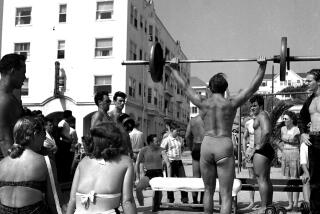BODIES: Why We Look the Way We Do and How We Feel About It<i> by Barry Glassner (G.P. Putnam’s Sons: $19.95) </i>
- Share via
Sure to be a hit on his inevitable tour of TV talk shows (especially among those sitting rather than exer-cycling in front of the tube), sociologist Barry Glassner contends that there’s nothing unhealthy about being slightly plump or about preferring gardening to trendier sports like jogging. Glassner’s argument initially seems unconvincing: a paean to being sedentary, perhaps an invitation to disease. Glassner, however, more anti-fad than anti-fitness, presents persuasive evidence that voguish sports such as aerobic dance can be more dangerous and no more effective than light sports like daily walking. Glassner also scrutinizes the Paffenbarger Report, routinely cited as definitive evidence that moderate exercise increases longevity. Paffenbarger’s study, Glassner points out, was based on death rates of male Harvard graduates, whose median income is roughly twice the national average. “A moral of the Paffenbarger study,” Glassner writes, “would seem to be: Protect yourself from disease, go to a fancy university and make lots of money.”
America’s fitness revolution, Glassner believes, has acted as a smoke screen for a more fundamental cause of ill health in America: class inequality. “Thirty-five million poor and working-class Americans have no health insurance,” he writes. “Many more are malnourished or live on diets high in fat, salt and sugar because these are what they can afford.” This argument is not entirely persuasive, for the cheapest of diets--based on vegetables--also can be the healthiest. Later in the chapter, however, Glassner offers a more plausible explanation for why the poor eat unhealthfully.
The upper and middle classes, Glassner argues, buy into the Horatio Alger myth that one becomes healthy the way one becomes wealthy: through self-discipline and a wise investment of time and money. In contrast, “many working class and poor people, already disillusioned by the American myth that hard work and self-restraint bring prosperity, reject that route to health. They define it instead as a condition where you are free to let go and enjoy life.” Health-conscious Americans haven’t fared as well in this respect, Glassner implies, for surveys show that they actually have grown less satisfied with their bodies since the fitness revolution began in the early 1970s. Rather than developing a stable source of self-esteem, they have tried to meet ever-higher standards of beauty set by America’s $50-billion-a-year-fitness industries.
Glassner has an intriguing explanation for why the fitness revolution began in the 1970s: “Whether or not it actually improves our appearance, or our health, I believe body work gives us something we desperately crave in this post-Watergate, post-Vietnam, post-Ollie North age. It allows us to feel morally pure.” Glassner doesn’t substantiate his hunch, but one can find abundant evidence that he’s on target: Surveys by UCLA sociologist Alex Astin, for instance, show that young Americans, doubting their power to shape society, are turning their attention to more manageable concerns, such as self-improvement. The tragedy of this trend, as Glassner perceptively points out, is that no amount of exercise or healthy eating can satisfy this hunger for public morality.






